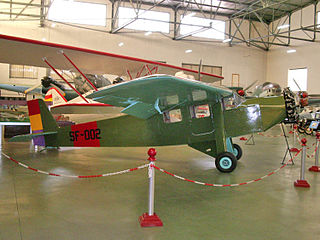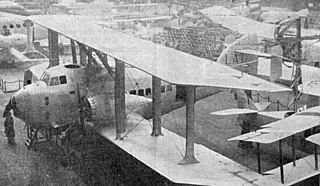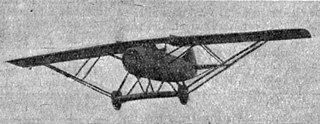Related Research Articles

The Farman F 400 was a 1930s French three-seat cabin high-winged monoplane which was designed and built by Farman.

The Farman F.120 and its derivatives were a family of multi-engine airliners and bombers of the 1920s built by the Farman Aviation Works in France.

The Farman F.190 was a utility aircraft built in France in the 1920s and 1930s. It was a high-wing, strut-braced monoplane of conventional configuration with a fully enclosed cabin and fixed, tailskid undercarriage. Popular both as a private aircraft and in the air taxi role, some 30 examples were also operated by airlines in France and elsewhere in Europe. Fifteen of these joined Air France's fleet in 1933 from the fleets of the smaller airlines it had absorbed.

The Farman F.200 was a civil utility aircraft produced in France in the 1930s. Derived from the F.190, it featured a revised fuselage that did away with its predecessor's enclosed cabin. Instead, it was a parasol-wing monoplane with open cockpits in tandem for the pilot and one or two passengers. Intended primarily as a trainer, it was also marketed as being suitable as a photographic platform or a mail plane.

The Farman F.300 and F.310 were airliners built in France in the early 1930s. They were high-wing strut braced monoplanes with fixed tailskid undercarriage with a trimotor layout popular with several manufacturers of the time. The cockpit and passenger compartment were fully enclosed. Most saw service in Farman's own airline, whose twelve F.300 variants made up half its fleet in 1931.

The Salmson-Moineau S.M.1 A3,, was a French armed three-seat biplane long range reconnaissance aircraft of the First World War designed by René Moineau for the Salmson company.

The Latécoère 4 was a three-engined, 15-passenger biplane built in France in the early 1920s. It proved difficult to fly and was discontinued, though a second machine was completed as the Latécoère 5 bomber.
The Farman F.1010 was a small, low-wing, single-seat monoplane ordered by the French government in 1931 to test in flight a large-calibre cannon. This was mounted between the cylinder banks of an inverted V-8 engine.
The Farman F.280 was a three engine, cantilever wing monoplane designed in France as a mail carrier in the early 1930s. Underpowered and slow, only two were built and briefly used.
The Farman F.250 was a small, four passenger single engine low cantilever wing airliner built in France in 1931. The single example built was bought by an airline but was little used, owing to stability issues.

The Farman Moustique is a family of French monoplanes built by the Société des Aéroplanes Henry et Maurice Farman at Billancourt.

The Farman FF 65 Sport was a French built light biplane, with a single engine and tandem seats, intended for sport and touring. First flown in 1919, it achieved modest sales at home and abroad in the early 1920s. Two unusual modifications produced a biplane glider and a low aspect ratio parasol wing machine.

The Farman F.90 was a single engine biplane transport, carrying 6 passengers. It was built and developed in France in the early 1920s. Though it had some competition successes, it was not put into production
The Sopwith Admiralty Types 137 and 138 were a pair of single-engine, two-seat naval biplane floatplanes, built to a British Admiralty order in 1914. They were similar in design, but having a more powerful engine the Type 138 was the larger and heavier. They were used in early torpedo dropping experiments in 1914.
The Sopwith Special torpedo seaplane Type C was the first British aircraft designed to drop torpedoes. A single-engine biplane seaplane, it flew in July 1914 but proved unable to lift the design load and was soon abandoned.

The Morane-Saulnier MS.341 was a single engine parasol wing training and touring aircraft built in France in the mid-1930s. It had two open cockpits in tandem and was sold to private owners, clubs and the Armée de l'Air.

The Caudron C.140 was a French tandem cockpit sesquiplane designed in 1928 as a combination of liaison aircraft and observer and gunnery trainer.

The Les Mureaux 3 C.2 and Les Mureaux 4 C.2 were French two seat, parasol winged fighters, flown in 1927-8, which differed only in their engines. They were developed into near identical army co-operation types, the ANF Les Mureaux 130 A.2 and ANF Les Mureaux 131 A.2, in 1929-31.

The Salmson-Béchereau SB-5 was a two-seat fighter aircraft built for a French government programme in 1925. Despite a powerful engine it did not perform well and only one was built.
The Farman F.290 was a 5-seat transport aircraft built in France in the early 1930s.
References
- 1 2 3 4 5 Liron, J.L. (1984). Les avions Farman. Paris: Éditions Larivère. pp. 38, 40, 46.
- 1 2 Davilla, Dr. James J.; Soltan, Arthur M. French aircraft of the First World War. Flying Machines Press. pp. 245–246. ISBN 1891268090.
- ↑ Parmentier, Bruno (24 March 2001). "Farman F.30B". Aviafrance (in French). Paris. Retrieved 22 December 2018.